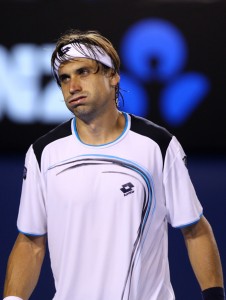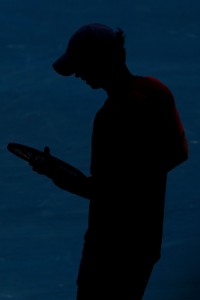Australian Open, Quarterfinals (Day Ten)
(1) Djokovic d. (5) Ferrer, 6/4 7/6 6/1
(4) Murray d. (24) Nishikor, 6/3 6/3 6/1
David Ferrer, in the press conference following his straight sets loss to Novak Djokovic last night, was asked whether the gap between the top four in men’s tennis and the rest of the field could be closed.  His response was blunt and realistic, indeed more so than his assessment of his own game had been: ‘No, I don’t think so . . . I think the top four, it’s another level.’
His response was blunt and realistic, indeed more so than his assessment of his own game had been: ‘No, I don’t think so . . . I think the top four, it’s another level.’
For a time the dull joke had been that the big four were a lock for the semifinals at every significant event they all entered, notwithstanding that it happened less frequently than most pundits realised. The joke became an absurdity last year, however, when it occurred more than anyone could believe. For all the talk of great depth in men’s tennis, such emphatic domination by an elite coterie of players has no precedent. Since the beginning of last year there have been five Majors contested (including the current Australian Open), which means there have been 20 semifinal berths available. The top four have filled 18 of those 20 spots, with the exceptions being Ferrer at last year’s Australian Open, and Tsonga at Wimbledon. Bear in mind that Ferrer defeated an injured Rafael Nadal for his spot, while Tsonga overran Roger Federer from two sets to love down, the first time this had happened in a Major. Had Nadal’s hamstring held together, and had Federer closed out that match, it could very well have been 20 from 20 spots. They aren’t the Big Four merely because they win everything, but because they stop anyone else from even getting close.
However, we must be careful here, and not collapse too readily into the trap wrought by a tight perspective. Viewed from within, the interminable can easily seem eternal, whereas a longer perspective reveals change. At the end of 2004, Federer’s first dominant season, the question was already asked whether anyone could actually challenge him at the top of the game. In July of 2005 Nadal commenced his record stint of 160 consecutive weeks at No.2. By 2007, we were again restive with the status quo, and began asking how the duopoly at the top might be broken apart. It turned out it couldn’t be (for now), but it could be augmented. By January 2008, Novak Djokovic had claimed his first Major, and had locked down the No.3 spot.  Within another eighteen months, Murray had broadened the elite once more. The Scot has yet to claim a Slam – and I may well be as sick of hearing about that as he is – but he has now reached the semifinals or better at six of the last eight Majors, and claimed eight Masters titles.
Within another eighteen months, Murray had broadened the elite once more. The Scot has yet to claim a Slam – and I may well be as sick of hearing about that as he is – but he has now reached the semifinals or better at six of the last eight Majors, and claimed eight Masters titles.
The certainty that the top four would therefore reach the semifinals at this Australian Open was so pervasive and obvious that even essaying predictions seemed like an exercise in going through the motions. (Plenty of people still went through those motions, largely because ‘draw analysis’ is virtually self-generating content.) Whether your picks were based on sound statistical modelling, a vague gut-feeling, or a consultation with your local haruspex, the outcome was much the same. With the semifinal line-up locked in, interest turned to the quarterfinals, and to the question of who might actually be challenged in the final eight. Most people picked Berdych to face Nadal, del Potro to face Federer, Tsonga to face Murray, and Ferrer to face Djokovic. There was some variation engendered by the vagaries of nationalism – such as Tennis.com’s insinuation of Fish or Isner into the final eight – but most objective observers seemed to predict that configuration for the quarterfinals. For the most part, they were correct. Only Tsonga failed to make it the cut, falling to Kei Nishikori in five sets the round before. If certainty in the final four inspires a eulogy on the death of men’s tennis, then being able to predict the final eight surely broadens it into a requiem.
This notion – that there is a discernible Little Four directly below the Big Four – was also put to Ferrer in his presser. He shirked engaging with the idea, perhaps due to the clumsiness of the question itself. He knows that while his lesser group may have pushed through to the quarterfinals as predicted, in some cases it was a close run thing, and that once there, only Berdych offered much resistance. He seemed resigned to this. Perhaps that’s the issue. It’s hard to resist the idea that we all are, and that even the other 124 guys in the draw were as certain as the rest of us precisely who would remain standing once 128 became four.
